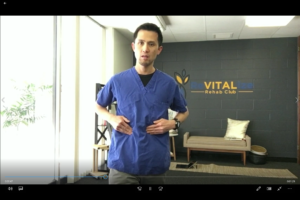Running is an exercise that many people go-to due to the convenience and cost-effective aspect of the sport. Holistic Sports Medicine Physical Therapist in Long Beach, Dr Danh Ngo dives into what makes the neck vulnerable when running in Part 1. This article, we detail a neglected system that is important for recovery after a run. We have seen 100’s of runners, and many have nagging injuries because they are not targeting key areas within the body that produce the spring in the running motion.
In part one (click HERE) in this article, we introduced the 4 factors that can slow or halt a runner from. The four factors are tissue pliability (flexibility), coordination (ability to control your body to keep your body in motion with the least amount of energy use), recovery, and endurance plus strength. The first part of this series has 10 simple exercises that will address the two key factors of tissue pliability and coordination.
Energy efficiency is important when it comes to having a long-running career. You can achieve energy efficiency through two methods. The two methods is to leverage and use the human body’s design the way it is intended or to develop your own running style over a very long time period that it becomes “muscle memory”. Our preferred method is to leverage the human body’s anatomy and use your muscles and fascial highway to your advantage. Fascia is a sheath of connective tissue that brings muscles together to produce more force like a whip or spring. The muscle memory concept is acceptable and is called “Tissue Adaptation Time”. The TAT principle is how we rehabilitate runners back to a healthy form. The problem with the latter reason is that your muscle memory becomes lost when you sustain an injury. You have to relearn your muscle memory again, and if it took you 10+ years to learn, then you might be in trouble if you are naturally impatient.
When the foot hits the ground and your thigh pulls your leg back, like a paddleboarder moving on the water, this stores energy and becomes released by your hip flexors with minimal energy. Your hip flexors are a group of two muscles that connects from your low back spine and discs and connects to your inner thigh bone and inner pelvic rim. Another great example of energy efficiency is your lower leg and foot complex. In our article “Instruction-manual-on-how-to-run-like-tony-starks-iron-man“, we talk about the Fibularis Longus and Posterior Tibialis Tendon cross-weaving around each other to produce a sling like spring.
With that being said, we believe the biggest room to improve or the most neglected system that many runners ignore is the ability to recover from a repetitive pounding activity like running, sprinting, or jogging. If you run more frequently during the week, your lack of recovery tactics will spill over to the next day. You are relying on your body’s muscle memory to help you run and less of running efficiency. Ideally, you want to drive a hybrid car while on a full gasoline tank.
Yes, it is a luxury, but your body needs this from time to time, right?
 TIP 1: Whole body lymphatic drainage sequence.
TIP 1: Whole body lymphatic drainage sequence.
The lymphatic system is our detox drainage system that is known more for helping our immune system. The word detox does not mean a “juicing” protocol of diet but indicates the assistance of eliminating the waste products our body makes from food, environment, stress response, and improper movements. Our body goes into tissue repair every day from micro-trauma like a car does from driving on the freeway.
We do not have a good 5000 miles oil change protocol but imagine how much more mileage we can push our bodies if we did.
Click HERE to watch how to manually detox and help your lymphatic system.
TIP 2: Strengthening your Hip Stabilizers
Lunge Dips:
This is a progression of the 1/2 kneel. Kneel one knee down on a sofa cushion. Back foot is in line with your hips and toes tucked under your shin. Without moving your feet, pop up into a semi-lunge position.
Endurance: Hold for 20-30 seconds. If you find this easy then, perform with your eyes closed. Repeat 10 times.
Strength: Go in and out of this position and tally how many you can perform in 2 minutes. Each week you need to increase this number.
TIP 3: Strengthening your Ankle Stabilizers
Heel Raises 3-ways
Stand with your feet hip-width apart. Pop up onto your toes without your ankles buckling. If your ankles are weak, then hold this for 30-6o seconds first before progressing.
Endurance: Go in and out of this position and tally how many you can perform in 2 minutes. Each week you need to increase this number. Point your feet inwards and repeat the same movement pattern. Point your feet outwards and repeat the same movement pattern.
Strength: Perform the same movement pattern but at an incline. Stand about 4 feet away from the wall. Lean forward and place your hands on the wall. Move up onto your toes and down. Perform for 10-12 reps with feet pointing straight, inwards and outwards.
TIP 4: Strengthening your Middle Back Stabilizers
quadruped Mid Back Rotation
Get on your elbows and knees. Twist your upper body by gently pushing from your bottom elbow into the ground.
Strength: Place an elastic band around your shoulders from behind. This will add resistance during your twist. Perform 10 reps for 3 sets.
Endurance: Same movement but for 20 repetitions, and on your hands instead. Make sure your elbows do not buckle.
Tip 5: Strengthening your Arch Muscles
Toes Splaying
We cannot give you a comprehensive running program without adding an exercise for your arch region.
Sit and attempt to spread your toes apart. Hold this for 10-20 seconds. You may feel a cramp but do not give up. Rest and repeat. If you cannot spread your toes, use your hands to put your toes in a spread position. Use your toe muscles to keep it from recoiling back.
Strength: Stand up. If that is easy, then perform with an elastic band around the forefoot.
Endurance: Stand up. Perform while standing on a sofa cushion. Hold for 30-60 seconds. Repeat 3 times.
Hope you find these exercises enjoyable. Let us know in 3-6 weeks of your transformation.
Photo credit: Thanks https://traineracademy.org/ for use of the cover photo of the runner. Please click on the link to learn more about Trainer Academy.
If you find these exercises too difficult, do not get discouraged. Reach out to use by clicking on the green button and schedule your special #Getanswer1st TELE-health chat with Dr Ngo. You can choose to have this conversation over the phone or via Skype. We will determine if your case is something we can help and get you back to running form again.
Stay strong and One LOVE,
Dr Danh Ngo
ReVITALize Rehab Club
Bixby Knolls, Long Beach Physical Therapy
Holistic Spine and Sports Medicine Expert
562.548.0876


